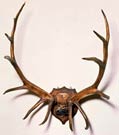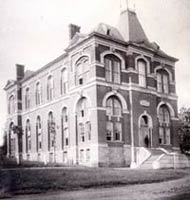In 1825, the year before he died, Jefferson wrote a letter to William Clark in which he clearly signaled his intention to give his collection to the University of Virginia, the foundation of which he referred to as the "hobby of his old age." He wrote Clark to solicit donations for a museum he planned for the University:
"Among other objects of our instn [institution] is the collection of a Museum of Nat. hist. [natural history] Of Minerals, & of curiosities in general of art or nature. Those of Indian arts stand very near to nature itself. Your situation is so favble [favorable] for assisting us in this collection that I cannot help soliciting your attention to us. . . . I give to the Univ. the whole of my collections which is considerable and much indeed of which was furnished me from the expedn. [expedition] of yourself & Govr. Lewis to the Pacific."
 It seems that in keeping with Jefferson's statement of his intentions in this letter, his collection of Native American material and natural history specimens ended up at the University of Virginia. The ultimate fate of much of the collection remains a mystery however. In October 1826, according to the records of the meetings of the Visitors (trustees) of the University, a room on the first floor of the Rotunda "was to be finished and fitted for the reception of the natural and artificial curiosities given to the University by the late venerable Rector [Jefferson]; and to have them there suitably arranged for preservation and exhibition." Surprisingly, exhaustive searches at the University over many years have not turned up any records itemizing or cataloguing Jefferson's "natural and artificial curiosities."
It seems that in keeping with Jefferson's statement of his intentions in this letter, his collection of Native American material and natural history specimens ended up at the University of Virginia. The ultimate fate of much of the collection remains a mystery however. In October 1826, according to the records of the meetings of the Visitors (trustees) of the University, a room on the first floor of the Rotunda "was to be finished and fitted for the reception of the natural and artificial curiosities given to the University by the late venerable Rector [Jefferson]; and to have them there suitably arranged for preservation and exhibition." Surprisingly, exhaustive searches at the University over many years have not turned up any records itemizing or cataloguing Jefferson's "natural and artificial curiosities."
The minutes of the meetings of the Visitors record frequent movement of the collection between 1828 and 1848, suggesting that it was forced to give way to the growing spatial needs of the Professors of Natural Philosophy and Chemistry. In 1828 the objects were moved from the first floor of the Rotunda to the basement to make room for scientific apparatus; the next year they moved to the upper gallery. In 1830 the Visitors approved the creation of a Museum in the basement story. In 1831 Franklin Peale, one of the sons of Charles Willson Peale who ran the Peale Museum after his father's death, traveled to Charlottesville to organize and arrange "the collection known under the denomination of Mr. Jefferson's donation." In October of the same year a young woman named Ann Maury recorded in her diary that she visited the University and saw the lecture rooms and library in the Rotunda. She reported seeing "some of Mr. Jefferson's collections of curiosities, Indian utensils & dresses & weapons & a part of a mammoth's skeleton." This is the only known account written by someone who saw Jefferson's collections at the University.
In 1840 the Visitors were again required to make provisions for the collection, this time approving the purchase of additional cases. The following year it appears that the museum's location in the Rotunda was changed again to create space for more lecture rooms. In 1848 the collection seems to have left the Rotunda; former dormitory rooms on the Lawn at the University were "appropriated to the reception of the objects in the Jefferson Museum" as well as other mineralogical and geological collections, suggesting that at this time the Jefferson collection was still understood as a concrete entity.
 In 1878 the Brooks Museum opened its doors on the University of Virginia grounds; it was a free standing museum of natural history, given to the University by Lewis Brooks of Rochester, New York. A student publication, the Virginia University Magazine, had reported in 1876 that geological "specimens of Mr. Jefferson's own accumulation" would be incorporated into the new collections that had been purchased for the Brooks Museum. It is certain that other natural history specimens from Monticello's Entrance Hall, most notably the Lewis and Clark elk antlers, moose antlers acquired by Jefferson in 1784, and mastodon bones excavated by William Clark in Kentucky following the expedition, also found a home in the Brooks Museum. It remains unclear whether any Native American objects from Jefferson's collection were in the Brooks Museum.
In 1878 the Brooks Museum opened its doors on the University of Virginia grounds; it was a free standing museum of natural history, given to the University by Lewis Brooks of Rochester, New York. A student publication, the Virginia University Magazine, had reported in 1876 that geological "specimens of Mr. Jefferson's own accumulation" would be incorporated into the new collections that had been purchased for the Brooks Museum. It is certain that other natural history specimens from Monticello's Entrance Hall, most notably the Lewis and Clark elk antlers, moose antlers acquired by Jefferson in 1784, and mastodon bones excavated by William Clark in Kentucky following the expedition, also found a home in the Brooks Museum. It remains unclear whether any Native American objects from Jefferson's collection were in the Brooks Museum.
The Brooks Museum was dismantled in the late 1940s, and its collections dispersed to various University departments. At the time of the dispersal, Jefferson's collection seems to have no longer survived as a recognizable entity. The elk and moose antlers were loaned back to Monticello by the Biology department in 1949 and mastodon bones by the Geology department in 1960. All of these loans remain at Monticello. The elk antlers are thus the only original Lewis and Clark objects from Jefferson's collection to survive at Monticello today.
